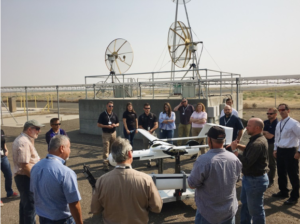Insitu, a wholly-owned subsidiary of The Boeing Company, is playing the long game. The company is drawing from Boeing’s experience as the world’s largest aerospace company and planning for the future with the ScanEagle 3, collaborating heavily to be sure that they stay out in front of commercial drone regulation.
The ScanEagle 3 is an sUAS, but it’s not a prosumer model. Currently, Insitu’s website lists the product under defense hardware – but it’s an aircraft that is also ideal for long endurance commercial use. The newest version of the ScanEagle accomodates multiple payoads simultaneously, and is field proven for security and durability.
Insitu has already worked through the process of getting the ScanEagle free of International Traffic in Arms Regulations (ITAR) – which means it can be imported without special paperwork and laws applied to defense related equipment. Now, the company is working on getting the ScanEagle 3 “type certified” by the FAA.
A type certification is, essentially, an airworthiness certificate. For civil aircraft, this is the first step of a 4 part certification process, followed by a production certificate and an airworthiness certificate for a particular aircraft and then an airline operating certificate. Having the aircraft “type certified” and “production certified” means that the FAA has approved the design and manufacture of the aircraft as being safe and airworthy.
Obviously, for a long endurance industrial drone hoping to enter the commercial market, this would offer a major advantage in applying for airspace waivers and authorizations, and proving that the aircraft is low-risk as the FAA adopts risk-based regulations. It’s not an easy process, however, and it’s one that requires heavy collaboration with the FAA.
“Recently, key FAA teams including Aircraft Certification (AIR), Aircraft Flight Status (AFS), Air Traffic Organization (ATO), and Aircraft Unmanned Systems (AUS) came together at Insitu’s headquarters in Bingen, Washington for the TCBM, a first for the group of FAA teams,” says an Insitu press release. “The FAA teams participated in an overview of Insitu’s Project Plan for Certification, examining Insitu’s “Detect and Avoid” (DAA) capability planning, along with its Safety Management System and proprietary model–based engineering. The three-day agenda included launch-to-capture flight tests, as well as standards, flight training and technical publications and manuals reviews to ascertain Insitu’s proposed basis for 2019 UAS Type Certification.”
“Insitu demonstrated its stringent culture of safety which mirrors the FAA’s extremely strict safety standards, exhibited the ScanEagle3’s innovative design and technology milestones that it has reached, as well as the fact that it is a mature aircraft company,” says the release. ” The aircraft type certification (TC) under 14 Code of Federal Regulations (CFR) 21.17(b) requires that an aircraft and its subassemblies are manufactured according to the approved design (known as the “type”) and that the design ensures compliance with appropriate standards. At that point a standard Certificate for a special class vehicle (UAS) will be issued by the FAA.”
“This exercise was to underscore our collaboration with the FAA, and to be completely transparent with our engineering details, software, and proprietary information,” said Jeff Raymond, Insitu Program Manager. “We are very forward thinking in working with the FAA to ensure UAS safe integration into the National Airspace System (NAS), enabling the many uses for UAS. These uses include data collection, analysis and delivery; aerial infrastructure survey; disaster recovery; wildfire suppression, and many more,” Raymond continued. “This certification will allow us to operate UAS without delay — which currently is due to seeking permits and temporary flight restrictions — making us agile and ready to serve at a moment’s notice.”
Miriam McNabb is the Editor-in-Chief of DRONELIFE and CEO of JobForDrones, a professional drone services marketplace, and a fascinated observer of the emerging drone industry and the regulatory environment for drones. Miriam has a degree from the University of Chicago and over 20 years of experience in high tech sales and marketing for new technologies.
Email Miriam
TWITTER:@spaldingbarker
Subscribe to DroneLife here.
https://dronelife.com/2018/10/25/how-do-drone-companies-plan-for-future-regulations-collaborate-with-the-faa/
 Unmanned Aerial Vehicle The latest drone news
Unmanned Aerial Vehicle The latest drone news




